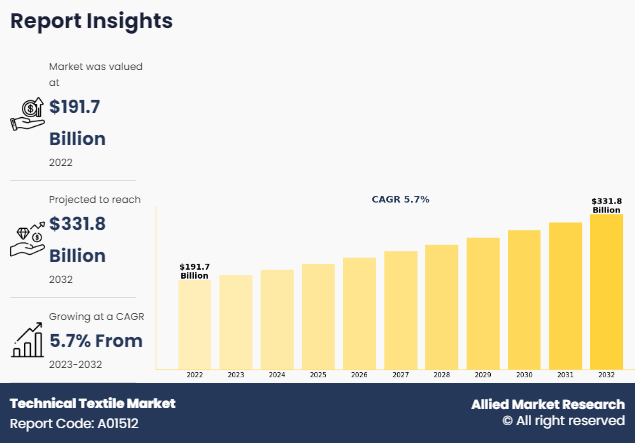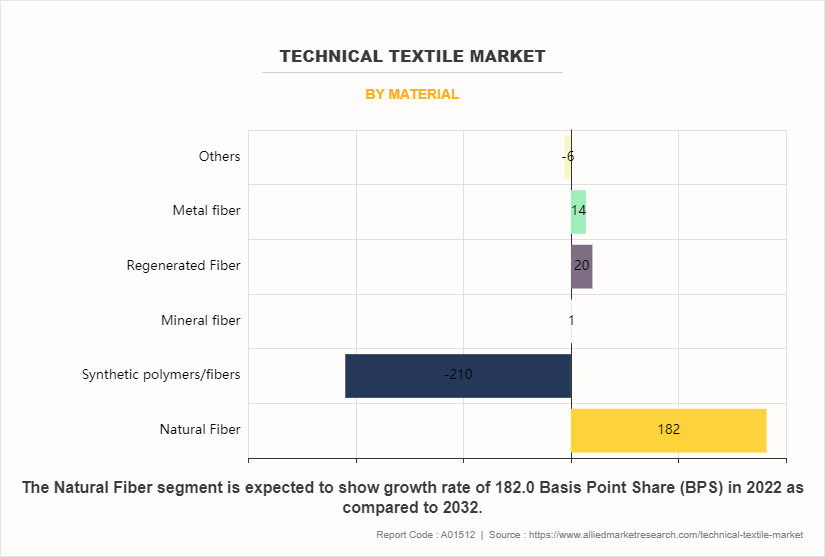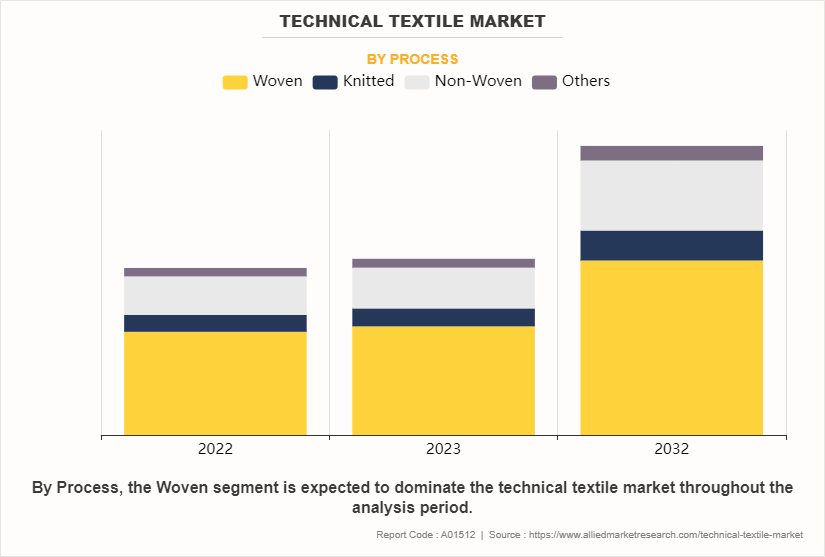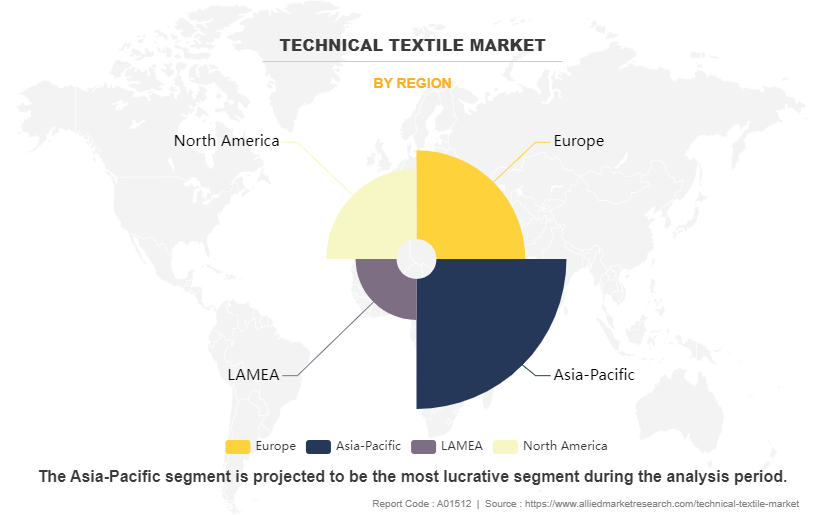Technical Textile Market Outlook - 2032
The global technical textile market size was valued at $191.7 billion in 2022, and is projected to reach $331.8 billion by 2032, growing at a CAGR of 5.7% from 2023 to 2032. Technical textile is well-known for its technical (mechanical, electrical, durable, and thermal) and functional properties, rather than decorative and aesthetic characteristics. It is used for technical applications such as protective clothing in the chemical industry, defense sector, automotive interiors, and others.

Introduction
Technical textiles are specialized fabrics designed for specific functional purposes beyond traditional textile uses. These textiles are engineered to meet performance requirements in various industries, including automotive, aerospace, healthcare, construction, and agriculture. Unlike conventional textiles, which focus primarily on aesthetics and comfort, technical textiles are developed for their durability, strength, and functionality. They offer properties such as resistance to abrasion, flame retardancy, water repellency, or UV protection. Examples of technical textiles include geotextiles used for soil stabilization, medical textiles like wound dressings and surgical gowns, and protective clothing for industrial workers. Technical textiles leverage advanced materials and technologies to provide enhanced performance and safety in demanding applications.
Key Takeaways:
- The report provides competitive dynamics by evaluating business segments, product portfolios, target market revenue, geographical presence and key strategic developments by prominent manufacturers.
- The technical textile market is fragmented in nature among prominent companies such as DUVALTEX, DuPont, Ahlstrom-Munksj, Berry Global, Inc, SKAPS INDUSTRIES, Asahi Kasei Corporation, Mitsui Chemicals, Inc, FREUDENBERG And CO. KG, HUESKER SYNTHETIC GmbH, BALTEX.
- The study contains qualitative information such as the market dynamics (drivers, restraints, challenges, and opportunities), public policy analysis, pricing analysis, and Porter’s Five Force Analysis across North America, Europe, Asia-Pacific, LAMEA regions.
- Latest trends in global technical textile market such as undergoing R&D activities, regulatory guidelines, and government initiatives are analyzed across 16 countries in 4 different regions.
- More than 3,000 technical textiles-related product literatures, industry releases, annual reports, and other such documents of key industry participants along with authentic industry journals and government websites have been reviewed for generating high-value industry insights for global technical textile market.
Market Dynamics:
The technical textiles market is anticipated to exhibit remarkable growth in future, due to rise in demand for cars with high-quality technological aspects. For instance, according to a report published by Alliance for Automotive Innovation in 2022, the electric vehicle sales in the U.S. increased by 6.3% during the first half of 2022 as compared to the sales during first half of 2021.
In addition, the competition in this sector is expected to increase the demand for MobilTech application in the technical textile market. The intense competition in the automobile sector in regions such as North America and LAMEA is expected to fuel the demand for MobilTech textiles material. In addition, the electric vehicle is expected to play a huge role in the automotive market and consequently the automotive textile demand; thus, fueling the technical textile market growth during the forecast period.
Additionally, the construction industry is a major consumer of technical textiles, utilizing them in geotextiles, architectural membranes, and reinforcement materials. As global infrastructure development and urbanization continue, the demand for technical textiles in construction is expected to rise. These textiles offer solutions for soil stabilization, drainage, and environmental protection, contributing to the longevity and sustainability of infrastructure projects.
Furthermore, the increasing emphasis on safety and protection across industries has driven the demand for technical textiles in the production of protective clothing, including flame-resistant apparel, chemical-resistant suits, and high-visibility garments. The need for personal protective equipment (PPE) in industrial settings, healthcare, and emergency services fuels the growth of this segment within the technical textile market.
However, the production of technical textiles often involves advanced technologies and specialized machinery, leading to high initial capital expenditures. This can be a barrier for new entrants and smaller companies. Also, many potential end-users may not be fully aware of the benefits and applications of technical textiles. Limited knowledge and understanding of the capabilities of these textiles may slow down technical textile industry growth.
Segment Overview:
The technical textile market is segmented on the basis of material, process end-use application, and region. On the basis of material, the market is categorized into natural fiber, synthetic polymers/fibers, mineral fiber, regenerated fiber, metal fiber, and others. On the basis of process, it is divided into woven, knitted, non-woven, and others. By end-use application, the technical textile market is classified into MobilTech, InduTech, SporTech, BuildTech, HomeTech, ClothTech, MediTech, AgroTech, ProTech, PackTech, GeoTech, and OekoTech. Region-wise, the market is studied across North America, Europe, Asia-Pacific, and LAMEA.

Technical Textile Market By Material
By material, the synthetic polymers/fibers segment accounted for the highest share in terms of revenue. Synthetic fibers are widely used in applications, including automotive, clothing, construction, filtration, home furnishing, and others. Thus, increase in population along with the urbanization drives the growth of the synthetic fiber market in the upcoming years. In addition, increase in trend of light weight accessories for electric vehicle to get best performance further boosts the market growth for synthetic fiber technical textile market. Moreover, change in lifestyle patterns demand for well-furnished homes which can be fulfilled with the help of synthetic fibers, which in turn fuels the technical textile industry growth globally.

Technical Textile Market By Process
By process, the woven segment accounted for the highest share in terms of revenue. Woven textiles are classified on the basis of weave, thread density, number of yarns & crimps and others. The properties such as durability, strength, stability, porosity control and others are the key factors that are expected to increase the demand for woven technical textiles during the forecast period. There is increase in use of woven textiles in the heavy applications such as highway engineering, railroad construction, airport runway construction and others in the last decade, which in turn fuels the growth of the woven technical textiles market in the upcoming years.
Technical Textile Market By End-Use Application
By end-use application, MobilTech accounted for the largest share, in terms of revenue. The competition in this sector is expected to increase the demand for MobilTech applications in the technical textile market. The intense competition in the automobile sector in regions such as North America and LAMEA is expected to fuel the demand for MobilTech textiles material. In addition, the electric vehicle is expected to play a huge role in the automotive market and consequently the automotive textiles demand.

Technical Textile Market By Region
By region, Asia-Pacific is projected to grow at the highest CAGR during the forecast period. The technical textile market size is expected to witness considerable growth in the coming years in India, owing to numerous factors such as developing end-user sectors, rising awareness, government initiatives, investment in technology, and others. Some of the developing end users include healthcare, automotive, construction, and others.
Competitive Analysis:
The technical textile market forecast is done based on ongoing industry trends, current industry performance, and historical scenarios. Companies profiled in the report include DUVALTEX, DuPont, Ahlstrom-Munksj, Berry Global, Inc, SKAPS INDUSTRIES, Asahi Kasei Corporation, Mitsui Chemicals, Inc, FREUDENBERG And CO. KG, HUESKER SYNTHETIC GmbH, BALTEX. These industries majorly holds the technical textile market share. The technical textile market share analysis helps analyze the key players and their growth strategies.
The other players in the value chain of the market include Bruck Textiles, Gelvenor Textiles, Lanxess, NIKOL Advance Materials Pvt. Ltd, Sanrhea Technical Textiles Limited, Arville Textiles Limited, L. van Heek Textiles bv, HiltexTechnischeWeefsels B.V., Delcotex, Aurich Textiles GmbH, and others.
Industry Trends
The technical textile market is experiencing significant growth due to rise in demand for technical textiles in various sectors, including healthcare, construction, automotive, and agriculture. One key trend is the increasing use of smart textiles integrated with electronic components like sensors and conductive fibers. These smart textiles are widely utilized in healthcare for patient monitoring and in sportswear for tracking performance. The growing interest in wearable technology has driven manufacturers to develop textiles that combine functionality with comfort.
Sustainability is another trend shaping the technical textile market. With consumers and governments emphasizing eco-friendly products, manufacturers are investing in recycled and biodegradable materials. For instance, the use of recycled PET bottles to create geotextiles and agro-textiles is gaining momentum. In addition, innovations in bio-based fibers and sustainable production methods, such as waterless dyeing and low-energy consumption, are gaining traction to meet environmental standards.
In construction and infrastructure, the use of geotextiles and non-wovens for soil stabilization, erosion control, and filtration is increasing. Governments' focus on infrastructure development, especially in emerging markets, drives the demand for technical textiles. Furthermore, fire-retardant, high-strength, and lightweight textiles are becoming crucial in automotive and aerospace applications, offering enhanced safety and fuel efficiency. These trends are expected to continue propelling market growth.
Government Initiatives for Promoting the Utilization of Technical Textiles
The U.S. promotes technical textiles through the Berry Amendment (10 U.S.C. 2533a), which requires the Department of Defense to give preference to domestically produced textiles. The National Textile Center (NTC) Program and Advanced Functional Fabrics of America (AFFOA) initiative also support research and development in advanced textiles, fostering innovation in technical textiles for defense, healthcare, and industrial applications.
In Canada, the Strategic Innovation Fund (SIF), Stream 5 (2017) focuses on advancing innovative manufacturing, including technical textiles. The Canadian Textile Industry Program (CAN-Textiles) promotes research, development, and commercialization of advanced textiles. Through the Canadian Environmental Protection Act (CEPA) 1999, Canada also regulates the production of eco-friendly technical textiles, pushing for more sustainable practices.
Furthermore, the European Union supports technical textiles through the Horizon Europe (Regulation (EU) 2021/695) research and innovation framework, which funds projects related to advanced materials and textiles. The EU Regulation (EU) 2016/425 on personal protective equipment sets stringent standards for technical textiles used in safety and medical applications. The Circular Economy Action Plan (COM (2020) 98 final) encourages the use of sustainable textiles in line with Europe’s environmental goals.
In India, the National Technical Textiles Mission (NTTM) (2020-2024) under the Union Budget 2020-21 aims to promote the domestic technical textiles sector by providing funds and facilitating research. China’s Made in China 2025 strategy emphasizes the development of advanced materials, including technical textiles, while Japan’s Technical Textiles Act (Law No. 44 of 1948, amended in 2014) supports the innovation and commercialization of high-performance textiles.
Key Benefits For Stakeholders
- This report provides a quantitative analysis of the market segments, current trends, estimations, and dynamics of the technical textile market analysis from 2022 to 2032 to identify the prevailing technical textile market opportunities.
- The market research is offered along with information related to key drivers, restraints, and opportunities.
- Porter's five forces analysis highlights the potency of buyers and suppliers to enable stakeholders to make profit-oriented business decisions and strengthen their supplier-buyer network.
- An in-depth analysis of the technical textile market segmentation assists in determining the prevailing market opportunities.
- Major countries in each region are mapped according to their revenue contribution to the global market.
- Market player positioning facilitates benchmarking and provides a clear understanding of the present position of the market players.
- The report includes an analysis of the regional as well as global technical textile market trends, key players, market segments, application areas, and market growth strategies.
Technical Textile Market Report Highlights
| Aspects | Details |
| Market Size By 2032 | USD 331.8 billion |
| Growth Rate | CAGR of 5.7% |
| Forecast period | 2022 - 2032 |
| Report Pages | 605 |
| By Material |
|
| By Process |
|
| By End-Use Application |
|
| By Region |
|
| Key Market Players | DUVALTEX, Ahlstrom-Munksj, BALTEX, DuPont, HUESKER SYNTHETIC GmbH, Mitsui Chemicals, Inc, FREUDENBERG & CO. KG, Berry Global, Inc, Asahi Kasei Corporation, SKAPS INDUSTRIES |
Analyst Review
As per the perspective of the CXOs of leading companies, the technical textile market is witnessing significant demand for medical textiles from the healthcare sector. In the coming years, there will be a considerable demand for medical textile from developed regions, owing to rise in awareness about personal hygiene. The growing healthcare industry in developing regions is one of the major factors expected to offer lucrative opportunities in the coming years for the key market players operating in the market.
Innovations in material science & technology, rising demand from end-use industries, and growth in construction and infrastructure are the upcoming trends of Technical Textile Market in the world.
MobilTech is the leading application of Technical Textile Market.
Asia-Pacific is the largest regional market for Technical Textile.
The global technical textile market was valued at $191.7 billion in 2022 and is estimated to reach $331.8 billion in 2023, growing at a CAGR of 5.7%.
Asahi Kasei Corporation, Ahlstrom Munksjö, Baltex, Berry Global, Inc., Berkshire Hathaway Inc., Dupont De Nemours, Inc. (Dupont), Duvaltex, Freudenberg & Co. KG, GSE Environmental, HUESKER Synthetic GmbH, Kama Holdings Limited, KONINKLIJKE TEN CATE BV, Milliken & Company, Mitsui Chemicals, Inc., and SKAPS Industries are the top companies to hold the market share in Technical Textile
Loading Table Of Content...
Loading Research Methodology...


